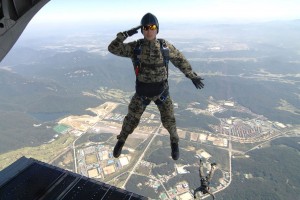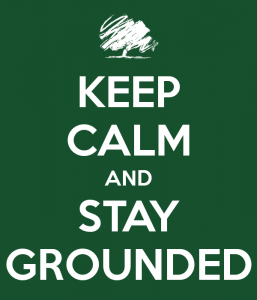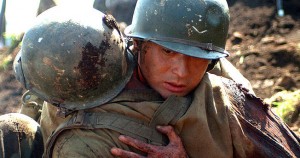Checkout Time: Touch Practice and Dissociation
 One of the wonderful things that can happen during a Touch Practice session is that the person I am working with becomes so comfortable and relaxed, he drifts off to sleep and naps while I hold him. Sometimes it is actual sleep, complete with purring, and sometimes my partner will experience more of a “zoning-out” of mental process, the cessation of thinking, which provides an equally satisfying sense of having rested.
One of the wonderful things that can happen during a Touch Practice session is that the person I am working with becomes so comfortable and relaxed, he drifts off to sleep and naps while I hold him. Sometimes it is actual sleep, complete with purring, and sometimes my partner will experience more of a “zoning-out” of mental process, the cessation of thinking, which provides an equally satisfying sense of having rested.
Typically when the partner “returns” from either sleep or this deeply relaxed state, there is a sense of satisfaction and happiness, deep connection to and within the self, with all of the physical manifestations of grounding one would expect.
However, a number of years ago, as I was still exploring and refining my practice, I recognized that people can sometimes go to sleep for other reasons, not all of them good. Sleep can be an indicator that something is “off” in Touch Practice, a warning sign that partner is in over his head.
Today I want to talk about the differences in partners who have gone to sleep because they feel relaxed, happy and safe, vs. partners who have gone to sleep because they are in trouble.
These two states, to a casual observer, might seem to look almost the same physically, but they could not be more opposite emotionally: in the first case, a person sleeps because he feels so safe and comfortable; in the second, someone feels so unsafe and uncomfortable that he has checked out of his body. I want to talk about how to discern relaxation from checking out, something requiring careful and constant observation of certain physical attributes. It’s an important skill, especially in working with people who have experienced past trauma.
 The psychological term that describes this state of “checking out” is dissociation. Dissociation occurs in everyday life on a regular basis: anyone who has ever gotten lost in thought while driving a car, magically stopping at the red lights and making all the right turns while having been “elsewhere,” mentally speaking, the entire time, has experienced dissociation. The thought process detaches from the physical activity, as though we were two separate beings, one driving the car, while the other figures out what to do about the heating bills.
The psychological term that describes this state of “checking out” is dissociation. Dissociation occurs in everyday life on a regular basis: anyone who has ever gotten lost in thought while driving a car, magically stopping at the red lights and making all the right turns while having been “elsewhere,” mentally speaking, the entire time, has experienced dissociation. The thought process detaches from the physical activity, as though we were two separate beings, one driving the car, while the other figures out what to do about the heating bills.
{Note that the photo here does not merely illustrate a man experiencing dissociation, but rather, a man being a complete idiot. This is a topic that deserves an entire article of its own, at a later date.}
Dissociation in its most severe form generates what we know as multiple personality disorder. In the middle, we use dissociation as a defense or coping mechanism. Dissociation is a common feature of both post-traumatic stress disorder and one of the ways we cope with sexual abuse, assault, or other traumas.
 If you’ve read me for a while, you know that two particular populations of people I have held in Touch Practice are soldiers with combat trauma and people who experienced sexual abuse as kids. Dissociation can be expected to appear frequently in people who have had these kinds of experiences. In order to avoid inadvertently stepping into these traumas or reinforcing them, I have had to learn to watch carefully for signs of dissociation.
If you’ve read me for a while, you know that two particular populations of people I have held in Touch Practice are soldiers with combat trauma and people who experienced sexual abuse as kids. Dissociation can be expected to appear frequently in people who have had these kinds of experiences. In order to avoid inadvertently stepping into these traumas or reinforcing them, I have had to learn to watch carefully for signs of dissociation.
On the less serious side of the dissociative spectrum, I’ve also written about how people who have sought Touch Practice with a partner but accidentally ended up with “just sex” make that accidental left turn in a very specific way: they hold their breath. And the breath is the key indicator here, the thing to watch more closely than anything else we watch.
 First, one of the guiding principles of Touch Practice is that it features gentle engagement, with a limited degree of challenge. As I like to say, “Touch Practice is not Outward Bound. It’s not about facing your deepest fears and jumping out of a plane.” It’s more about learning how to relax, deeply, and feel comfortable and safe in your own experience.
First, one of the guiding principles of Touch Practice is that it features gentle engagement, with a limited degree of challenge. As I like to say, “Touch Practice is not Outward Bound. It’s not about facing your deepest fears and jumping out of a plane.” It’s more about learning how to relax, deeply, and feel comfortable and safe in your own experience.
We use a 1-10, low-to-high scale of “how much challenge are you experiencing” when we do Touch Practice. If we get to 5, we slow down and pay really careful attention. If we get higher than 7, we stop and talk for a bit. There’s no work to be done above 7, and the essential work of Touch Practice has to be done at 3 and below.
If you push your partner too hard or too fast, or if you work at too high of a challenge level, in my experience you significantly increase the possibility that he may get in over his head. In encouraging people to come into their bodies and feel safe, the last thing we want to do is set up a situation where they check out.
Next, we spend a great deal of time in Touch Practice establishing physical grounding, which involves the posture of the feet in the floor, and deep, slow, regular, breaths that sit down around the belly or the hips. In a 75 minute Touch practice with a new partner I might spend 15 minutes, or one fifth of the time, only focused on establishing grounding. I want to make sure the person is grounded and aware of his experience before we engage any level of challenge.
 A grounded person is balanced squarely on both feet, has spring in the knees (is not rigid) and has the sensation that he is slowly getting heavier and heavier in the feet. It is not possible to knock a grounded person off balance, so in standing practice if someone is wobbly or feels frail or easily moved, I’m not satisfied that grounding has been established.
A grounded person is balanced squarely on both feet, has spring in the knees (is not rigid) and has the sensation that he is slowly getting heavier and heavier in the feet. It is not possible to knock a grounded person off balance, so in standing practice if someone is wobbly or feels frail or easily moved, I’m not satisfied that grounding has been established.
The quality of breath in a grounded person is rhythmic and regular. If you watch your partner carefully you can note moments of challenge because the breath will stop briefly when there’s challenge. Typically people will hold their breath when they are touching a new part of the body (the chest, for example, or the genitals.) Gently reminding your partner, “breathe!” is a hidden gem of keeping your partner safe, because you are helping keep him in his experience. It’s the single most important safety feature in Touch Practice.
A good partner never loses touch with his partner’s breathing (or his own, for that matter.) It should become a habit that is so automatic it no longer requires thinking about. I have become so attuned to the way my breathing fits with my partner’s breathing that there’s almost a form of music or rhythm that comprises the basic fabric of a Touch Practice session with someone.
The physical body of a person who is grounded and relaxed is supple but reactive. That is, the body is pliable and soft, not armored, and if I put energy into that part of the body (by touching, squeezing or hugging it, for example) the body will respond back–there will be some sort of reactive or echoing response.
 The physical body of a person who is dissociated is limp, and non-reactive. The body is not armored, and feels somewhat similar to the soft “puppy body” state, but it is non-reactive; there is no echoing response, no answer to inquiring touch. It feels like no one is home. These two states are strikingly dissimilar, but it amazes me how in early practice I did not always recognize one from the other until the practice had already passed. It does require paying attention.
The physical body of a person who is dissociated is limp, and non-reactive. The body is not armored, and feels somewhat similar to the soft “puppy body” state, but it is non-reactive; there is no echoing response, no answer to inquiring touch. It feels like no one is home. These two states are strikingly dissimilar, but it amazes me how in early practice I did not always recognize one from the other until the practice had already passed. It does require paying attention.
I hope these things are useful to those of you who are engaged in deeper practice on a regular basis. Touch Practice is an ideal venue for those who wish to engage difficult experiences of the past in an environment of safety, kindness, and sacred alliances with each other, and our ability to create safety for and with each other is only limited by intention and skill. Anyone who wishes to practice can increase a sense of safety both for himself and others.
Brothers, let us love one another. Happy Thanksgiving.
Have thoughts you’d like to share?
Touch Practice is a sacred practice for me, and part of that is keeping confidences sacred. While a name and e-mail address are required to post a comment, feel free to use just your first name, or a pseudonym if you wish. Your e-mail address will never be seen by or shared with anyone. It is used to prevent spam and inappropriate comments from appearing in the blog. I’d really like to hear from you!













